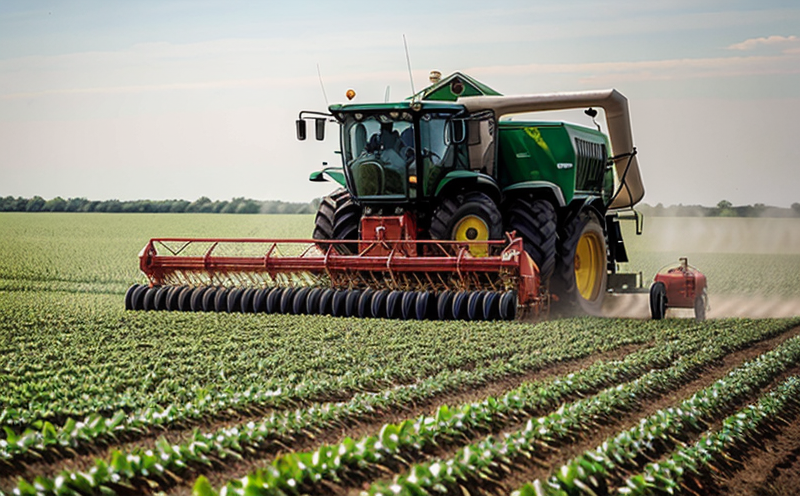Chlorophyll Content Testing (SPAD Meter)
The Chlorophyll Content Testing service using a SPAD meter is essential in agriculture and forestry for evaluating the health, vigor, and productivity of crops. This non-invasive technique allows for quick measurement of chlorophyll content in leaves without causing damage to plants or altering their environment. The SPAD meter measures the absorbance of light by leaf tissues at specific wavelengths, providing a direct indicator of chlorophyll concentration.
Chlorophyll is crucial for photosynthesis, which converts sunlight into energy that sustains plant growth and productivity. By monitoring chlorophyll content, farmers and researchers can identify stressed or nutrient-deficient plants early on, enabling timely interventions such as irrigation, fertilization, or pest control. This non-destructive method is particularly valuable in precision agriculture where real-time data is required for optimizing resource use.
The SPAD meter operates based on the principle of reflectance spectroscopy. It measures the intensity of light reflected from leaf surfaces at two different wavelengths (usually 650 nm and 940 nm) and calculates chlorophyll content using a proprietary formula. The result is expressed as an SPAD value, which correlates directly with chlorophyll concentration in parts per million (ppm). This method ensures high accuracy while providing rapid results.
The service typically involves the following steps:
- Sample collection: Fresh, representative leaves are selected from various parts of the plant to ensure a comprehensive assessment.
- Preparation: The leaves are cleaned and kept in a controlled environment until testing.
- Measurement: The SPAD meter is calibrated according to manufacturer guidelines before use. Leaves are placed on the device's probe, which measures chlorophyll content instantly.
- Data analysis: Raw data is processed using software that may apply additional corrections for environmental factors such as leaf moisture or thickness.
The accuracy of SPAD meter readings can be influenced by several factors including:
- Leaf water content: Excessively dry or wet leaves may yield inaccurate results.
- Leaf thickness: Thicker leaves may block the light, leading to underestimation of chlorophyll content.
- Environmental conditions: Temperature, humidity, and lighting can affect readings if not controlled during testing.
To ensure reliable SPAD meter results, it is recommended to:
- Calibrate the device before each use according to manufacturer guidelines.
- Use a standard reference material for calibration checks.
- Test under consistent environmental conditions whenever possible.
- Avoid testing on leaves with visible damage or disease.
The SPAD meter plays a vital role in precision agriculture by offering actionable insights into plant health and productivity. By integrating this service into routine monitoring, stakeholders can enhance crop yield, reduce waste, and optimize resource use. This non-invasive technique supports sustainable agricultural practices while improving overall efficiency.
Applied Standards
The SPAD meter follows several international standards to ensure accuracy and consistency in chlorophyll content measurements:
- ISO 17025: Laboratory accreditation standard ensuring the competence of testing laboratories.
- ASTM E691: Practice for Conducting an Interlaboratory Study to Determine the Precision of a Test Method, which is referenced by many SPAD meter manufacturers for validating their devices.
- IEC 62305-1: Specification for safety requirements in electrical equipment used in agriculture and forestry.
Manufacturers also often reference EN ISO 976, which specifies the technical requirements of chlorophyll meters, ensuring that SPAD meters adhere to stringent quality control measures. These standards collectively ensure that SPAD meter results are reliable, repeatable, and comparable across different devices and laboratories.
Environmental and Sustainability Contributions
The use of SPAD meters in agriculture contributes significantly to environmental sustainability by promoting efficient resource management and reducing waste. By identifying stressed or nutrient-deficient plants early, farmers can apply targeted interventions, leading to reduced fertilizer usage and water consumption.
This precision approach not only enhances crop yield but also minimizes the ecological footprint associated with over-fertilization and excessive irrigation. Additionally, SPAD meters support sustainable land use practices by enabling more accurate assessments of plant health, thereby optimizing the allocation of resources such as land, labor, and capital.
The non-invasive nature of chlorophyll content testing further supports sustainability goals by minimizing stress on plants during monitoring processes. This reduces the risk of crop damage or loss due to testing methods that may harm the plants or their environment. By fostering healthier crops through early intervention, SPAD meters contribute to long-term environmental and economic benefits.
Use Cases and Application Examples
Crop Monitoring: Farmers can monitor crop health in real-time using SPAD meters during different growth stages. This allows for precise identification of nutrient deficiencies or water stress, enabling timely adjustments to irrigation and fertilization schedules.
Diagnostics: The service is particularly useful in diagnosing plant diseases by identifying chlorophyll content anomalies that may indicate underlying issues such as nutrient imbalance or pest infestation.
Research: SPAD meters are employed in agricultural research to study the effects of various environmental factors on plant health. This helps researchers develop more resilient crop varieties and better understand the mechanisms of photosynthesis.
Training: Educational institutions use SPAD meters as tools for teaching students about plant physiology and chlorophyll function. The hands-on experience provided by this service enhances learning outcomes in agricultural sciences.
Commercial Applications: In addition to the above, SPAD meter testing is also used in commercial settings such as nurseries, greenhouse operations, and seed companies for quality control and product evaluation.





